nginx模块结构
在nginx中,以ngx_module_t结构体抽象模块,ngx_module_t关联一组ngx_command_t命令数组和一个ngx_*_module_t上下文。示意图如下:

ngx_module_t定义了7个方法:
ngx_int_t (*init_master)(ngx_log_t *log);ngx_int_t (*init_module)(ngx_cycle_t *cycle);ngx_int_t (*init_process)(ngx_cycle_t *cycle);ngx_int_t (*init_thread)(ngx_cycle_t *cycle);void (*exit_thread)(ngx_cycle_t *cycle);void (*exit_process)(ngx_cycle_t *cycle);void (*exit_master)(ngx_cycle_t *cycle);
这7个方法在nginx中会在不同的时机被调用,nginx各功能模块和非功能模块,可以通过这7个方法在不同的时机插入自己的业务代码。
如,ngx_event_core_module就通过init_process来完成如下几件事情:
- 初始化
ngx_posted_accept_events和ngx_posted_events双向链表 - 调用
ngx_event_timer_init初始化定时器 - 调用
ngx_event_actions_t结构体中的init方法,如对于epoll模块来说,这方法为:ngx_epoll_init - 预创建
cycle->connections连接数组,并将每个连接关联上读写事件结构体:ngx_event_t - 构建
cycle->free_connections空闲连接列表 - 为每个监听端口关联一个
ngx_connection_t,并将监听套接字的可读事件回调设置为ngx_event_accept或ngx_event_recvmsg,然后注册监听套接字的可读事件
ngx_command_t命令解析结构体
每个ngx_module_t可关联一个ngx_command_t数组,每个ngx_command_t结构对应nginx.conf配置文件中的一个指令。ngx_command_t结构体定义如下:
struct ngx_command_s {
ngx_str_t name;
ngx_uint_t type;
char *(*set)(ngx_conf_t *cf, ngx_command_t *cmd, void *conf);
ngx_uint_t conf;
ngx_uint_t offset;
void *post;
};
该结构体各成员说明如下:
- name: 指令名称
- type: 指令级别和指令参数定义
- set: 指令解析函数
- conf: 结构指针偏移
- offset: 结构体成员偏移
- post: 不常用
如,解析http配置块的指令定义如下:
static ngx_command_t ngx_http_commands[] = {
{ ngx_string("http"),
NGX_MAIN_CONF|NGX_CONF_BLOCK|NGX_CONF_NOARGS,
ngx_http_block,
0,
0,
NULL },
ngx_null_command
};
模块上下文
不同的模块类型有不同的模块上下文,如:
NGX_CORE_MODULE类型的模块对应的上文为ngx_core_module_tNGX_EVENT_MODULE类型的模块对应的上下文为ngx_event_module_tNGX_HTTP_MODULE类型的模块对应的上下文为ngx_http_mdule_tNGX_MAIL_MODULE类型的模块对应的上下文为ngx_mail_module_tNGX_STREAM_MODULE类型的模块对应的上下文为ngx_stream_module_t
那么,模块上下文一般承担什么样的职责呢?
如,ngx_core_module_t的定义为:
typedef struct {
ngx_str_t name;
void *(*create_conf)(ngx_cycle_t *cycle);
char *(*init_conf)(ngx_cycle_t *cycle, void *conf);
} ngx_core_module_t;
该上下文结构主要定义了一个配置创建和初始化函数。
如,ngx_event_module_t的定义为:
typedef struct {
ngx_str_t *name;
void *(*create_conf)(ngx_cycle_t *cycle);
char *(*init_conf)(ngx_cycle_t *cycle, void *conf);
ngx_event_actions_t actions;
} ngx_event_module_t;
该上下文结构同样有配置创建和初始化函数,另外还有类型为ngx_event_actions_t的成员,该结构体定义如下:
typedef struct {
ngx_int_t (*add)(ngx_event_t *ev, ngx_int_t event, ngx_uint_t flags);
ngx_int_t (*del)(ngx_event_t *ev, ngx_int_t event, ngx_uint_t flags);
ngx_int_t (*enable)(ngx_event_t *ev, ngx_int_t event, ngx_uint_t flags);
ngx_int_t (*disable)(ngx_event_t *ev, ngx_int_t event, ngx_uint_t flags);
ngx_int_t (*add_conn)(ngx_connection_t *c);
ngx_int_t (*del_conn)(ngx_connection_t *c, ngx_uint_t flags);
ngx_int_t (*notify)(ngx_event_handler_pt handler);
ngx_int_t (*process_events)(ngx_cycle_t *cycle, ngx_msec_t timer,
ngx_uint_t flags);
ngx_int_t (*init)(ngx_cycle_t *cycle, ngx_msec_t timer);
void (*done)(ngx_cycle_t *cycle);
} ngx_event_actions_t;
该结构体试图抽象不同平台的网络I/O接口。
ngx_http_module_t的定义为:
typedef struct {
ngx_int_t (*preconfiguration)(ngx_conf_t *cf);
ngx_int_t (*postconfiguration)(ngx_conf_t *cf);
void *(*create_main_conf)(ngx_conf_t *cf);
char *(*init_main_conf)(ngx_conf_t *cf, void *conf);
void *(*create_srv_conf)(ngx_conf_t *cf);
char *(*merge_srv_conf)(ngx_conf_t *cf, void *prev, void *conf);
void *(*create_loc_conf)(ngx_conf_t *cf);
char *(*merge_loc_conf)(ngx_conf_t *cf, void *prev, void *conf);
} ngx_http_module_t;
该上下文结构定义了不同层级的配置创建和合并函数。
从上面的例子可以看出,模块上下文主要用于:
- 创建和初始化(或合并)配置结构
- 表达业务模块独有的概念,如在事件模块中,定义了
ngx_event_actions_t结构来表示一系列的网络I/O行为
«Previous: nginx扩展模块编程
»Next: None.